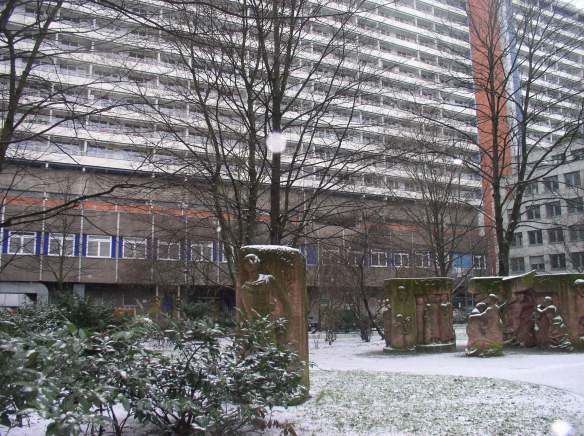 In the previous article, we’ve seen that German resistance during the Second World War could have been ambivalent. A plot to overthrow the Nazi regime for the sake of an intensified war against the Soviets can (easily) be confused for an attempt in name of justice. However, there was a group of average women which protested against the Nazi regime in the middle of WWII. These women were regular citizens, though their jewish husbands were victims of a roundup through Germany in February 1943. In the heart of Hitler’s capital, it came to a protest. What happened? What was the result? How is this courageous event remembered?
In the previous article, we’ve seen that German resistance during the Second World War could have been ambivalent. A plot to overthrow the Nazi regime for the sake of an intensified war against the Soviets can (easily) be confused for an attempt in name of justice. However, there was a group of average women which protested against the Nazi regime in the middle of WWII. These women were regular citizens, though their jewish husbands were victims of a roundup through Germany in February 1943. In the heart of Hitler’s capital, it came to a protest. What happened? What was the result? How is this courageous event remembered?
In the morning of 27 February 1943, the SS and the Gestapo started the ‘Evakuierungsaktion’ in the whole of Nazi Germany. In this round up, jewish men were imprisoned before they were deported to concentration and extermination camps. The Fabrikaktion was completed within two days, except in the German capital. In Berlin, where the biggest jewish population lived, the action took over a week. During the Fabrikaktion, 8000 Berlin men were rounded up from their homes or one of the 100 different companies. They were gathered in six locations – among them a concert hall, two barracks, a synagoge and a jewish senior center. The men who were imprisoned in these locations were were generally deported to Theresienstadt before they mostly were killed in Auschwitz.
The 2000 men who were married to an ‘Aryan’ women were after the Fabrikaktion imprisoned at the office of the Jüdischen Gemeinde (Jewish Community) in the Rosenstraße. In the following days – hundreds of women and relatives, sometimes around the thousand, spontaneously gathered in front here. The protest was not violent – which would have been without a change against the armed soldiers and SS who guarded the office. Most of the time, the mass on the Rosenstraße looked to the office and talked to each other. Sometimes it came to a roaring – and the screaming was widely heared. At one day, machine guns were placed in front of the mass – and army trucks drove nearly into the demonstrating crowd in an attempt to drive it out. The men who were kept in the Rosenstraße were released one by one from the 2nd of March onwards. Twenty-five men who were deported to Auschwitz on the fifth of March were sent back two weeks later – except for one man, who became sick due to the awful circumstances and was not allowed to travell back. All the surviving men of the Fabrikaktion were forced to labour, close under the nazi’s repressive eye.
There is discussion if it is due to the demonstrations that their men survived. The historian Jana Leichsenring postulates that the men were saved after an intervention of cardinal Adolf Betram. This catholic official had been an opponent of the nazi’s since the first hour – and wrote a letter when he heared of the Fabrikaktion and the protest in the Rosenstraße. According to Wolf Gruner, a historian who is specialised in the Nazi regime and genocides, it was due to a decree on 20 February that the men survived. This decree told that certain groups – such as the mixed marriaged, were not allowed to be deported. According to Gruner, the men were hold because the nazi’s wanted to investigate their marital status. As far I can see, the pression of a catholic official can’t be the equal thread as a revolting mass in the city’s centre. Also, I wouldn’t trust the Nazi regime and its declarations when it comes to holding a jew for ‘investigation’. It is likely that the Fabrikaktion would have been performed even more thoroughly in Berlin than was strictly needed. The round up and deportations were partly the result of a cruel speech by Joseph Goebbels, the Minister of Propaganda and also Berlin’s fanatic Gauleiter (Region Leader). This ambitious anti-semite declared that Berlin should be ‘Judenrein’ (‘clean of Jews’) by the beginning of 1943. The Fabrikaktion can be seen as the implementation of this. At the sixth of March 1943, Goebbels noted in his diary that a crowd stood in front of the Jüdisches Alterheim. Goebbels wrote that he had given order to the Sicherheitsdienst (Security Service) to postpone the deportations. So to speak, the gathering of ‘critical’ people in front of the Jüdisches Altersheim and the Jüdischen Gemeinde was considered to be dangerous. As I see it, the only case which nazi’s investigated seemed to be whether the women would give up their husband under high pressure or not. Besides, the twenty-five deported men were not different than the other ones. On top of that, a comparison with other cities shows that the Nazi authorities officially might protect the jews from mixed marriages, but rarely did. In Frankfurt am Main and Darmstadt there were jews in mixed marriages were deported by the middle of February 1943 and the following two months. There was no serious protest. The degree from higher officials that jews from mixed marriages should not be deported came in May – which was way too late.
The event in the Rosenstraße was barely remembered for the first three decades, till books came up about this topic by the late seventies. The first publication with the protest as its main theme was written in 1990, followed by another five publications in the following thirteen years. In the meanwhile, GDR’s succesful artist Ingeborg Hunzinger was given order in develop a sculpture in the Rosenstraße, which was presented in 1995. The monument is called Der Block der Frauen (The Women Block), consisting five stone parts – showing demonstrating women and imprisoned men. Directly at the location of the former Jüdischen Gemeinde, a Litfaßsäule (advertising column) is erected, giving information about what happened here 70 years ago. Also, a small memorial panel is developped at the office building – where once stood the office of the Jüdischen Gemeinde.
In 2003, a film about the situation in the Rosenstraße came into cinema. Although it is critisised for being historically incorrect, for example – most of the man from mixed marriages did not have to wear the stigmatising yellow, jewish badge. Nevertheless, I would recommand this film – perhaps it’s just that the courageous Rosenstraße protest has more of my sympathy than the film about Valkyrie (see previous entry). In my opinion, the director of Rosenstraße made a better effort to show the chaotic atmosphere and the development of the protest – which may not have been as spectacular as we actually hoped it would be.
Other memorials remembering the Fabrikaktion are situated at the locations where the men were gathered before their deportation. In 1960, a memorial stone remembers the Kristallnacht and the deportations from within the jewish synagoge in the Levetzowstraße, which is demolished. A statue of packed people being deported by a train carriage remember the victims of the deportations since 1987. An iron board next to it shows how many jews were deported, at which day and where to. At the Jüdisches Altersheim, a bronse statue of thirteen figures made by Will Lammert was placed close by graveyard to remember the jewish victims of fascism. It remembers that 55.000 jews were deported after they were gathered in the senior center. The statue was actually erected at concentration camp Ravensbrück in 1957, but moved to East Berlin in 1985. Also, the former walls of the senior center is marked with red stones. At the Daadgallerie in the Zimmerstraße, a memorial stone remembers the history of the building in which the Fabrikaktion also is noticed. This building was a concert hall, already used by nazi officials before the Fabrikaktion took place. Other places were jewish men were gathered during the Fabrikaktion were in two barracks – namely the Julius-Leber-Kaserne, which was once named the Hermann-Göring-Kaserne. The other barrack was located at the Rathenower Straße in Moabit. No memorial stones are erected at these barracks.
Taking everything into account, we see that the Rosenstraße protest was not seriously remembered before the late seventies. Then, a slow consciousness came up about the forgotten courage of the (mainly) female crowd. Perhaps, the feminist emancipation of the seventies helped in this memorisation. Because the demonstrating crowd was anonymous and without an organisation, there are no streets named after the heroines. And although there is debate if the protest only was decisive for releasing the imprisoned men in the Rosenstraße, it is clear that these women made the most courageous effort to save the most stigmatised and persecuted group within Nazi Germany.

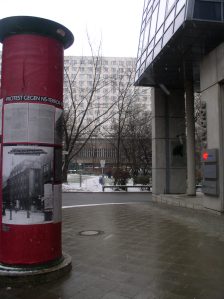
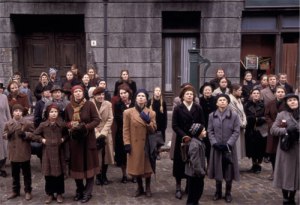
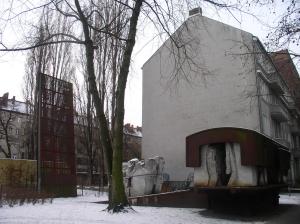
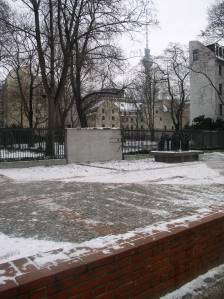
Pingback: The Holocaust and the Holocaust Memorial. A few insights, evoking many questions… | Historical tales about the capital of the 20th century
Pingback: Overview | Historical tales about the capital of the 20th century
Pingback: Making Berlin ‘Judenfrei’. The decimation of Berlin’s jewish population by railway deportations. | Histories from the capital of the 20th century